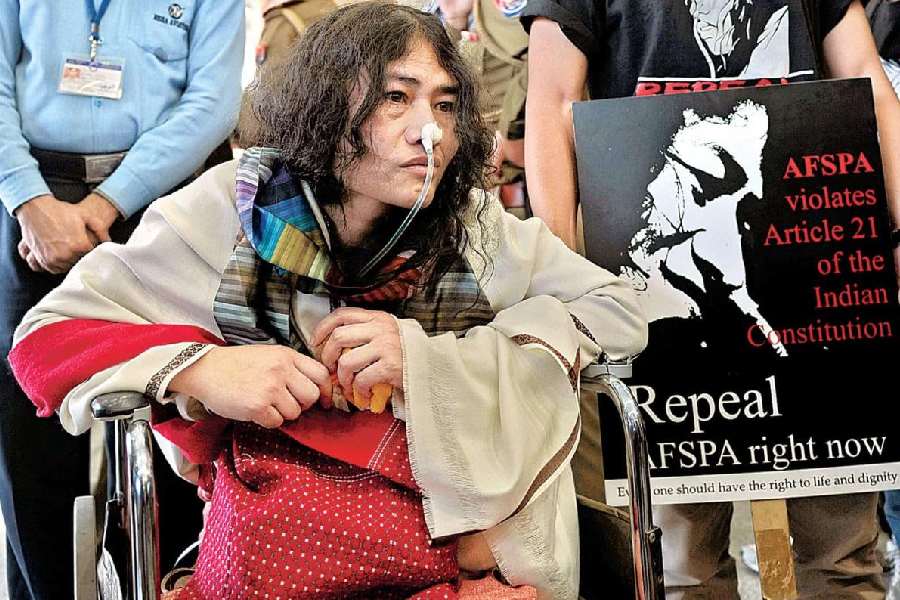The saga of rape and murder in Manipur is now widely known but little is known about the laws, such as the Armed Forces (Special Powers) Act, and the paramilitary authorities, the Assam Rifles, that are often complicit in such transgressions. In this piece, we will not be dealing with the rest of the Northeast, save briefly for Nagaland.
For instance, the massacre of innocents in Nagaland’s Mon district by the 21 Para of Assam Rifles reflects the contradiction between official policy and its actual implementation in the Northeast. I was posted as a senior police officer in Manipur and Tripura but had no power to take action if the men of any Central agency committed serious crimes: they are not accountable to the state government. Thus, Central forces personnel might indulge in rape and murder but the state police have no power to intervene to take preventive or punitive action. Only Central agencies are empowered to do so.
The AFSPA, described as a ‘truly nasty and terrifying piece of legislation’, came to prominence in a major case in 2004 in which a young woman, Thangjam Manorama, was arrested and killed by the men of the Assam Rifles who alleged that she was a member of a terrorist organisation who had committed an offence that could only be dealt with by a Central agency. Manorama was taken away from her home in the dead of the night and killed within hours because of the immunity provided to the perpetrators acting in ‘disturbed areas’ by the AFSPA. Paradoxically, although the Assam Rifles and the AFSPA are under the ‘administrative control’ of the Union home ministry, their ‘operational control’ was with the Union defence ministry. A significant aspect of the protest against the murder of Manorama was that a group of women protested by disrobing in front of the Assam Rifles headquarters in the state capital, demanding that they too be raped and killed like Manorama was.
In another major case in 2000, a young woman named Sharmila Chanu undertook a hunger strike demanding the repealing of the AFSPA after the Assam Rifles killed a group of innocents standing at a bus stop. However, the army authorities remained adamant that the AFSPA would remain in place as long as the insurgency lasted in Manipur. Sharmila was persuaded to give up her hunger strike 16 years later. But the AFSPA has remained in place.
In 2019, two innocent citizens, Sanjit and Rabina, a pregnant woman, were shot dead at a busy marketplace by the state police and the Assam Rifles, under the immunity provisions of the AFSPA, in the name of fighting insurgency.
Since the 1990s, several international human rights organisations, including the United Nations High Commissioner for Human Rights, have appealed to the Government of India to revoke the AFSPA as an unjust law. The government has defended the law.
The AFSPA is only one of the many laws in India that violate human rights. These have been discussed at length in civil society. The Jeevan Reddy Committee (2005) considered repealing the AFSPA but merely recommended that the law be incorporated into another repressive law of 2004 intended to prevent unlawful activities. This was not accepted since the government held that Assam Rifles was the principal Central agency concerned with security in the Northeast.
The AFSPA, it has been argued, provides a framework for security in Northeast India. But it has led to the inevitable militarisation of daily life in the region, imposing a huge psychological burden on the ordinary people. The insurgency in Manipur became a beneficial proposition for politicians, bureaucrats and middlemen who continued to milk the Central government of enormous funds. The simple solution would be to sit down and talk to the insurgent leaders and listen to their problems.
As stated earlier, the Jeevan Reddy Committee, which had reviewed the imposition of the AFSPA, wanted its basic provisions to be incorporated into the rival Unlawful Activities (Prevention) Act, 2004, to make it appear less discriminatory. The recommendation of the Committee was not accepted, presumably because of opposition from the army and the ministry of defence. The existence of the AFSPA undermined the role of the state police forces in the management of internal security. The then army chief, V.P. Malik, who had commanded an army division in counterinsurgency operations in Manipur, reportedly told the Manipur chief minister in 2004 that it was “either the AFSPA or no counterinsurgency operations.” The rigid stance of the army over the issue prevented the Centre from publicly releasing the Jeevan Reddy Committee report. Neither the prolonged protest fast by Irom Sharmila nor the powerful protest by the brave women of Manipur in front of the Assam Rifles headquarters was strong enough to persuade the Government of India to remove the AFSPA from Manipur. Such is the power of bureaucracy.
The continuance of the AFSPA in Manipur has led to a vast increase in human rights violations and killings. One of the main beneficiaries of this was the state police force, which emerged with a large number of gallantry medals profiting from the absence of accountability under the AFSPA.
The AFSPA in the Northeast had been a huge tragedy. Meanwhile, the Union home ministry, which is the nodal ministry for the National Human Rights Commission and responsible for the work of the Assam Rifles and the AFSPA, continues to provide huge funds annually for the management of ‘law and order’ in the Northeast.
K.S. Subramanian was Director-General of the State Institute of Public Administration and Rural Development in Tripura











